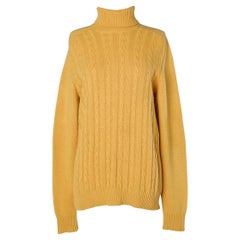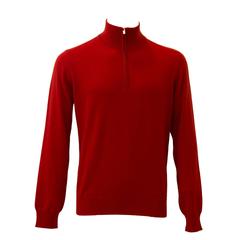Cachemire Pullover
Recent Sales
1980s French Pullovers
21st Century and Contemporary French Pullovers
21st Century and Contemporary French Pullovers
Hermès for sale on 1stDibs
For Hermès, what began as a maker of leather equestrian goods for European noblemen would eventually grow into one of the most storied fashion labels in the world. In 1837, German-born French entrepreneur Thierry Hermès opened a saddle and harness purveyor in Paris. Gradually, the house extended into accessories and luggage for its riders, and today, in paying homage to its origins, the family-run luxury brand resurfaces horse motifs in everything from clothing and modernist jewelry to pillows and handbags.
The first top-handled bag ever produced by Hermès was the Haut à courroies, which made its debut in 1892. A tall bag secured with a folded leather flap (fastened with bridle-inspired straps), it was designed to transport riding boots and a harness. As the world made the switch from horse to automobile, the bag adapted, becoming a multifunctional travel satchel instead of a designated saddlebag. Today, 120 years later, the HAC remains in Hermès’s line — and its distinctive flap and clasping straps have laid the groundwork for some of the house’s other iconic bags.
In the 1930s, Robert Dumas (son-in-law to Émile-Maurice Hermès, Thierry’s grandson) designed a smaller, trapezoidal take on the flap bag with a handle and two side straps. Later, actress Grace Kelly, then engaged to Prince Rainier of Monaco, is said to have used one of these bags to conceal her pregnancy during the 1950s. Because she was photographed constantly, the coverage catapulted her handbag to international popularity. In 1977, Hermès officially renamed the model for her, and the Kelly bag was born. Each Kelly bag takes between 18 and 25 hours to produce, and its 680 hand stitches owe solely to one Hermès artisan.
Robert Dumas was also responsible for another one of the brand’s most iconic offerings: the launch of its first silk scarf on the occasion of Hermès’s 100th anniversary in 1937. Based on a woodblock designed by Dumas and printed on Chinese silk, the accessory was an immediate hit.
Today, vintage Hermès scarves, typically adorned in rich colors and elaborate patterns, serve many functions, just as they did back then. Well-heeled women wear it on their heads, around their necks and, in a genius piece of cross-promotion, tied to the straps of their Hermès bags. Kelly even once used one as a sling for her broken arm.
In 1981, Robert Dumas’s son Jean-Louis Dumas, then Hermès chairman, found himself sitting next to French actress and musician Jane Birkin on a plane, where she was complaining about finding a suitable carryall for the necessary accoutrements of motherhood. After the two travelers were properly introduced, Birkin helped design Jean-Louis’s most famous contribution to the Hermès canon: the Birkin bag, a roomy, square catchall with the HAC’s trademark leather flap top and the addition of a lock and key. Owing to the brand’s legendary commitment to deft, handcrafted construction, the Birkin is an investment that is coveted by collectors everywhere.
While the Kelly and Birkin may be standouts, gracing the arms of everyone from royal heiresses to hip-hop stars in the past few decades, the handbags are but a small part of Hermès’s fashion offerings. Since the 1920s, the brand has produced some of the most desirable leather goods in the world. There’s the Constance bag, a favorite of Jacqueline Kennedy, the recently relaunched 1970s-era Evelyne and, on the vintage market, a slew of designs dating back to the 1920s.
Good design never goes out of style. Find a variety of vintage Hermès handbags, day dresses, shoes and more on 1stDibs.
Finding the Right sweaters for You
The vintage sweaters in your dresser may have humble origins, but they can’t be beaten for year-round fashion.
In the 15th century, sweaters originated as jersey tunics and other knitted shirts designed to keep sailors and fishermen warm. Later, during the 1880s in America, these knitted or crocheted vests or pullovers — in Britain, “jumpers” — were thought to substantially help athletes shed pounds as needed. Sweaters were an ideal garment for sports and outdoor events in the late 19th century. The knit fabric permitted movement but the material also protected against the cold. It wasn’t until the 1920s, however, that sweaters were introduced to the world of high fashion, thanks to pioneering designers such as Elsa Schiaparelli, Coco Chanel and Jeanne Lanvin.
A versatile garment, sweaters go well with most looks — from a casual gathering over drinks with friends to complementing a professional ensemble for the office to a night out at the theater. Simply pair a timeless cardigan with slacks or a skirt and your nicest dress shoes for any occasion, in any season, to tie an outfit together.
Once they were considered en vogue, sweaters were no longer strictly made with natural fibers like wool. Over time, fashion designers introduced the use of softer, synthetic materials. Today, traditional sweaters, such as those made with merino wool, are just as popular as more modern creations, such as the sweater dress. Similar to sweatshirts, sweaters come in all kinds of materials, from light synthetic blends perfect for spring to heavier fabrics, like cable-knit wool, to stay cozy and warm in winter and embrace the Danish concept of hygge.
A crucial factor that goes into selecting the perfect sweater is the material. High-quality wool, such as merino wool, which is soft and breathable, will feel luxurious and keep you warm on even the chilliest of evenings. Alpaca fleece, the fibers of which are native to Peru, offers the same warmth as wool, but an alpaca sweater is going to feel even softer than a merino wool sweater, similar to cashmere. Who doesn’t want a slouchy, oversize sweater made of a mix of mohair, nylon and wool on those subzero East Coast nights?
It’s important to note that wool can be a finicky material, easy to stain or distort and stretch. Synthetic materials are not only lightweight, but a nylon or polyester sweater will also be easier to wash and care for. If you opt for wool, take care of your sweater — fabric shavers, fabric combs and the local dry cleaner are your friends.
Sweaters come in various styles like V-neck, turtleneck and crewneck, which is the most popular style. For those extra cold days, a turtleneck offers added warmth without sacrificing style. Those looking for a casual touch that still emphasizes elegance can opt for a long tunic or scoop-neck pullover.
Maybe Versace or Gucci sweaters catch your eye, or ’90s fashion is your thing and a color-blocked sweater dress or John Galliano cardigan of the era is already a closet staple for you. Perhaps you’d rather opt for a 1970s long-sleeve knit top from Yves Saint Laurent. Either way, you’ll find exactly the black, beige or red vintage sweater you’re looking for in men, women or unisex styles today on 1stDibs.

